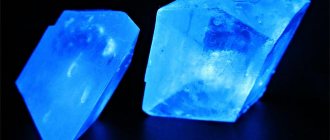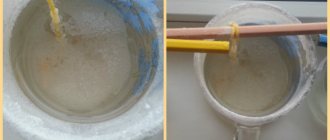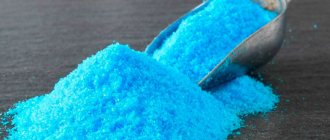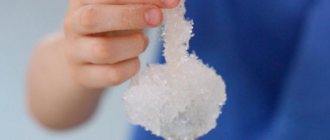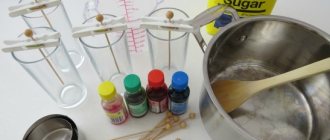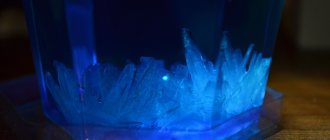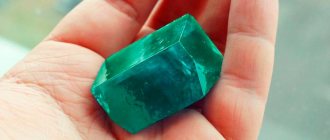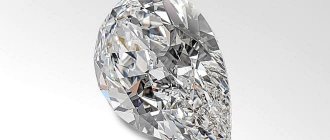The most interesting facts about crystals
- Translated from Greek, the word “crystal” meant “ice”. However, later the crystal acquired another name - rock crystal.
- Many of the most common substances around us are crystals. Freezing water turns into ice crystals or snowflakes. Every single particle of salt or sugar is also a crystal!
- The largest crystals exist in Mexico, in two caves. At a depth of more than 300 meters there are crystals 10-15 m long. They consist of selenite - transparent gypsum.
- Crystals reproduce themselves and thus grow. They can rightfully be called “living” creatures of nature.
- Today, almost all existing crystals are grown artificially. This way they get exactly what the end consumer needs. Crystal production is one of the most expensive and beautiful businesses. People who grow artificial crystals earn a lot of money. After all, “fake” ones are used to make such precious stones as sapphire and ruby.
A 4th grade student conducts individual research and creates a research project on the surrounding world on the topic “Growing crystals at home,” in which he carries out the process of seeding and growing crystals of salt and copper sulfate, before searching the Internet for the necessary information and analyzing it. The process of crystal growth turned out to be very curious and interesting.
More details about the work:
In the process of writing a research paper on the surrounding world, “Growing crystals at home,” an elementary school student grows crystals of salt and copper sulfate by cooling and removing water from a saturated solution, prepares concentrated solutions and seeds for crystals.
Before starting work on a research project on growing salt crystals and copper sulfate at home, the author studies information about the growth of beautiful crystals in caves, the types and structure of crystals, as well as their nature of occurrence. This research work will be useful for children to grow crystals at home, when studying the subject of chemistry or the world around them in elementary school.
Table of contents
Introduction
- Crystals in caves
- Growing crystals by cooling a saturated solution
- Growing crystals by removing water from a saturated solution
- Growing crystals from salt and copper sulfate
- Preparatory stage of growing crystals
- Preparation of concentrated solutions
- Seed for crystals
- Crystal growth
- Stages of growing crystals
- Literature on Crystal Growing
Introduction
I have several encyclopedias that I like to read. One day I saw photographs of very beautiful crystals. I became interested in what crystals are, how they appear, and whether they can be grown at home.
In my research work on crystals, I will study information about the existence of crystals in caves, the process of growing crystals at home from salt and copper sulfate, outline the stages of growing and ultimately plan to get my own crystals.
Project goal: to explore the possibility of growing crystals at home.
Object of study: crystal growing process.
Subject of research: the possibility of growing at home.
Research objectives:
- find information, study literature on growing crystals from salt and copper sulfate;
- grow crystals at home and monitor their growth;
- analyze the results obtained.
My research hypothesis: is it possible to grow crystals at home?
Research methods:
- accumulation of theoretical material;
- carrying out experimental activities in order to obtain crystals;
- analysis of the research results.
My research plan:
- Find out what a crystal is;
- Grow a crystal.
Now let's move directly to the content of our research work and trace the progress of the research.
Go to page 2 Crystals in caves
Content:
Crystals in caves Growing crystals by cooling the solution Growing crystals by removing water from the solution Growing crystals from salt and copper sulfate Preparatory stage of growing crystals Preparation of concentrated solutions Seed for crystals Growing crystals Stages of growing crystals Literature on growing crystals
If you liked the page, share it on social networks:
Growing sugar crystals at home
I decided to grow a crystal from sugar.
I needed: water; sugar; wooden sticks; transparent glasses; food colorings; thick paper; pot.
Take 1/4 cup of water and two spoons of sugar. Mix and heat until syrup is obtained. Dip a wooden stick into the syrup and sprinkle with a little sugar. Similarly, we make the required number of blanks and leave them to dry completely overnight.
In a saucepan of 2 glasses of water and 5 glasses of granulated sugar over low heat, stirring constantly, prepare the sugar syrup. After this, leave the syrup to cool slightly. We take pieces of paper slightly larger than the diameter of our glasses and pierce them with chopsticks. The main thing is that the paper is firmly fixed on the stick. The paper will serve as a holder and lid for the glass.
Pour the cooled but still hot syrup into glasses. Add a little food coloring, then the crystals will eventually turn out colored. We put our sticks with paper into the glasses and leave them alone until the crystal ripens . It is important not to touch the walls and bottom! Every day the crystals increase and after 7 days everything is ready!
The resulting sugar crystals are beautiful and also delicious!
Conclusion
When we talk about crystals, we most often imagine sparkling crystals of precious stones emitting light and color - topazes, rubies, amethysts, diamonds. But in fact, almost the entire world is made of crystals. Salt and sugar, snow, ice, clay and sand, hundreds of other substances - all these are nothing more than crystals.
As a result of the research, the hypothesis was completely confirmed: I was able to grow crystals from sugar at home . Crystals grow in a saturated solution as the liquid gradually evaporates.
Artificial growth of crystals is of great value to humans, since such crystals are widely used in science, technology, and optics.
The results of my research can be used in lessons about the world around us, and can also be of interest to other children.
The knowledge, skills and abilities acquired during the research will definitely be useful to me in my further studies in chemistry and physics lessons.
Applications
If you liked the page, share it on social networks:
Research work “Growing crystals”
Introduction
The topic of growing crystals is becoming increasingly relevant for all of humanity. Nowadays, crystals have literally entered every home.
At the heart of every television, cell phone, and computer is a crystal. Growing crystals preserves natural resources and accelerates scientific and technological progress. Now we know that even some parts of our body are crystalline, for example, the cornea of the eye. The world of crystals and the world of people have become inseparable.
Goal of the work
:
Grow crystals and determine what influences crystal growth.
Tasks:
1. Collect information about crystals.
2. Grow crystals of table salt and copper sulfate.
3. Identify the most favorable conditions for crystal growth at home.
4. Carry out work on analyzing the experiments performed, draw conclusions and present the results.
What is a crystal?
What is a crystal? Crystals are solids whose atoms or molecules occupy specific, ordered positions in space.
Structure of crystals.
All crystals consist of individual particles: molecules and atoms arranged in a strict order. They form a crystal lattice. Each atom is assigned a place in a specific lattice site, and regular polyhedra are formed. A crystal can have from three to several hundred facets. But at the same time they have a wonderful property. All flat faces intersect each other at certain angles. The angles between corresponding faces are always the same. For example, crystals of table salt (NaCl) always have their faces intersecting at right angles. Crystals are beautiful and varied. The secret of their beauty is symmetry.
Types of crystals.
Crystalline bodies can be single crystals or polycrystals.
A single crystal is called a monocrystal. (“mono” - one)
A polycrystal is a collection of randomly oriented small crystals fused together.
(“poly” - many)
If in a crystalline body crystallization began simultaneously at many points of the substance and its speed was sufficiently high, then we will get a polycrystal. Growing crystals are an obstacle to each other and prevent each other from being cut correctly.
We managed to grow one such polycrystal. !!!!!!!!!!!!!!!!!!!!!!!!!!!!!
But in this work we will mainly talk about single crystals.
Growing crystals.
There are different ways to grow crystals. This process often requires high temperatures and enormous pressure, but some crystals can be grown at home.
Crystal growth can be accomplished by gradually removing water from a saturated solution, that is, by evaporation.
For this we need crystalline powder and special dishes.
Stage 1: Preparation of a supersaturated solution. Dissolve the salt from which the crystal will grow in heated water (it needs to be heated so that the salt dissolves a little more than it can dissolve at room temperature). Dissolve the salt until you are sure that the salt is no longer dissolved, that is, the solution is saturated!
Stage 2: Filtration of the solution. The finished solution is filtered through a filter made from a regular paper napkin. Pour the saturated solution into another container where you can grow crystals (taking into account that it will increase).
Stage 3: Placement of seeds. Once the solution has cooled to room temperature, small seed crystals are added. Tie a thread with a seed, for example, to a match and place the match on the edges of a glass (container) where the saturated solution is poured. Dip the crystal into a saturated solution.
Step 4: Transfer the container with the saturated solution and the crystal to a place where there are no drafts, vibrations and strong light (growing crystals requires compliance with these conditions).
Step 5: Observe the growth and shape of the crystals. Now we need to wait. Every day the crystals will increase.
Cover the container with the crystal with something on top to prevent dust and debris from entering.
Analysis of completed work.
We conducted a number of experiments on growing a crystal at home.
Watching crystal growth is very interesting and educational.
1. We prepared a saturated solution of copper sulfate, cooled it to room temperature and placed a “seed” in a vessel with a supersaturated solution. The vessel was tightly closed with a lid. The next day we saw that the “seed” had dissolved. The “seed” was added to the solution again and the “seed” dissolved again. The third time the lid was not closed.
We concluded:
For crystal growth it is necessary that there is good evaporation of liquid from the surface of the crystal.
2. The following experiment was carried out to see whether an admixture of any substance could change the crystal of table salt.
We prepared a saturated solution of table salt, added red watercolor paint, a seed, and grew a crystal.
We examined the resulting crystal with a magnifying glass and saw that the angles between their faces were equal and equal to 900, i.e. straight lines.
We concluded
- the impurity only colors the crystal, but does not change its structure. Table salt (NaCl) crystals grow so that their edges intersect at right angles. That's what we observed.
3. We prepared a saturated solution of copper sulfate, and then poured it into two vessels, cooled it to room temperature and placed it in vessels with a supersaturated “seed” solution. One vessel was placed in a refrigerator, where the temperature was +30C, and the other was placed near a room heating radiator, where the temperature was +170C. After one day, the mass was measured on electronic scales, and the data was entered into the table.
We concluded
: the rate of crystal growth, i.e. the mass by which the “seed” has increased in one day, depends on the temperature. The higher the temperature, the faster the crystal growth rate.
Results of measurements of the mass of table salt crystals
| Time, day | Weight, mg | |
| At t =+17 0C | At t = +3 0C | |
| 0 | 500 | 500 |
| 2 | 700 | 500 |
| 4 | 1600 | 600 |
| 6 | 12400 | 580 |
| 8 | 16000 | 600 |
| 10 | 16200 | 710 |
| 12 | 16800 | 750 |
| 14 | 17200 | 780 |
The average growth of a crystal of table salt in a warm place was
1, 193 g/day, and in cold in cold – 0.02 g/day
Results of measurements of the mass of table salt crystals (NaCl)
Graph of crystal mass growth over time
Conclusions.
— For crystal growth it is necessary: to prepare a saturated salt solution and for liquid to evaporate from the surface of the crystal. Do not cover the solution tightly with a lid.
— The rate of crystal growth depends on temperature. In our experiments, we observed that the higher the temperature, the greater the rate of crystal growth.
— Crystals of table salt (NaCl) can have the shape of a cube, parallelepiped, prism or a body of a more complex shape, but their faces always intersect at right angles. Impurities added to the solution do not change this angle.
Application of crystals.
Crystals are one of the most beautiful and mysterious creations of nature. There is something amazing and mesmerizing about crystals. They amaze with their clarity of lines, which hides extraordinary beauty. Crystals have played and still play an important role in human life.
We live among crystals, we walk on them, and they are widely used in our daily lives. The earth's crust is 95% crystalline. We extract crystals from the depths of the earth, use them in laboratories, in technology, process them in factories, and create products from crystalline materials. Natural crystals have always aroused people's curiosity. Their color, shine and shape touched the sense of beauty, and people decorated themselves and their homes with them. All natural gemstones, such as diamond, ruby, sapphire and emerald, except opal, are crystalline. Almost all rocks: granite, sandstone, limestone are crystals. Crystals of quartz, calcite and other transparent substances that transmit ultraviolet and infrared radiation are still used to make prisms and lenses for optical devices. Semiconductor devices are made from crystalline substances, mainly silicon and germanium. Semiconductor diodes are used in computers and communications systems, and solar panels placed on the outer surface of spacecraft convert solar energy into electrical energy. The list of uses for crystals is already quite long and is constantly growing. Currently, the science of crystallography deals with the study of crystals.
Literature:
- Bokiy G.B. Crystal chemistry: Textbook. manual for universities / G.B. Bokiy - M.: Nauka, 1971.
- Geguzin Ya.G. Living Crystal: article / Ya.G. Geguzin - M.: Nauka, 1981.
- Shaskolskaya M.P. Essays on the properties of crystals: essays / M.P. Shaskolskaya - M.: Nauka, 1978.
- Crystals: essays / M.P. Shaskolskaya - M.: Nauka, 1978.
- Shafranovsky I.I. Symmetry in nature: / I.I. Shafranovsky – Leningrad. : Nedra, 1985
- Internet
Presentation:
/data/edu/files/n1463076699.pptx (Presentation_Crystals)
How to grow a crystal
So, the reagents in the experiment will be water and salt, and the equipment will be:
- two containers (glasses, half-liter jars or not too large pans);
- filter paper;
- thread or hair.
To grow a crystal you will need salt, water, thread and some kind of container
Note! Jars or glasses must be absolutely clean. Any speck on their inner surface can become the basis for the growth of additional crystals that will interfere with the main one.
Preparation of the solution
- First of all, you need to prepare a saturated saline solution. Pour water into the jar. It is desirable that it be distilled or at least filtered. Fill the container about 80%, place it in a water bath.
- At this time, add salt to the jar. If you use a cookware, you will be in for an unpleasant surprise - various debris that will float to the surface. Carefully remove it immediately or pass it through filter paper later. Sea salt is usually sold pure. Just don’t take flavored or colored ones with various additives, this will greatly harm the process.
- Add plenty of salt so that the solution becomes saturated. The recommended proportion is 100 g of product per 150 g of water. Some of the substance must remain at the bottom, because it simply cannot dissolve. Just at this stage, pour the liquid into another jar, at the same time getting rid of small debris and undissolved salt.
The salt solution must be very saturated
Sea or table salt crystal germ
Prepare the seeds on which the crystals will grow. They should be large so that you can easily attach them to the thread.
The easiest way to make a selection is as follows: pour salt into a salt shaker and shake until all the small crystals fall out. Those that did not pass through the holes of the salt shaker and remained inside are perfect for our purpose. Choose the largest one, with a shape close to a rectangle, with a minimum of deviations.
Try to choose the largest and smoothest crystals as the seed of a future crystal
Attach the selected embryo to a thread, and in turn, wrap it around a stick or pencil so that over time it is easy to adjust the depth of immersion.
The main and longest phase of the experiment begins. Immerse the embryos in a saturated solution, poured into a second jar, wrap the container with something warm so that the liquid cools more slowly.
If the solution was sufficiently saturated and pure, within a day the embryos will increase slightly. Otherwise they will dissolve.
Now cover the top of the jar with paper to prevent debris and dust from getting in, and leave for 3-4 days. The water will gradually evaporate, and the salt will precipitate, growing on the embryo and ensuring the growth of crystals.
Video: salt crystal
How to properly grow a crystal from salt, how to further decorate it and protect it from the effects of time, you can learn from the video materials. You can also admire the beautiful specimens grown by lovers of such an interesting art, and be inspired for similar feats.
Do you love doing science experiments and want to get your kids involved? The best way to do this is to try together to grow a crystal from ordinary salt, which everyone probably has in their home.
How to create a crystal from citric acid
The citric acid method of making stone requires more time and effort. To create a crystal yourself, you need to take 100 ml of water at a temperature of 20°C and dissolve 130 g of citric acid in it. The temperature of the liquid must remain the same, so the solution must be heated during the preparation process. For this purpose, use a container of hot water, lowering the container with the solution into it and controlling the heating of the liquid using a thermometer.
Citric acid crystal
Citric acid should be periodically added to the liquid throughout the week until it stops dissolving. The consistency is reminiscent of jelly, and small crystals will settle at the bottom of the dish. The resulting mixture must be poured into a jar through filter paper. One of the crystals that has settled to the bottom must be wrapped with a thread or fishing line and placed in the liquid.
After 12 days, the crystal will reach about 11 cm in diameter. It can be carefully removed and coated with clear manicure polish. If you plan to grow your stone larger, leave it in the container to continue growing. Growing a crystal from citric acid is presented in the video.
How to make a large white crystal from sea salt
When using the classic method of growing crystals, they are made from table salt, which is used for food. This product is available in large quantities on the shelves of any grocery store and is quite inexpensive. But which salts are best to grow crystals from? Sea salt will also serve the purpose. The difference is what the result will be.
To obtain unusual masterpieces of nature, you need to put a crystal from table salt in one container, and from sea salt in another. In the second case, the growth rate may be greater, as well as the density of the resulting stone. The appearance of the crystals may also differ, but only slightly, since the molecules of sea and table salt are almost the same.
- The State Duma will consider 3 options for indexing pensions
- 6 ways to tell about your health from your lips
- To whom and why do banks stop issuing credit cards?
To make a large white crystal from sea salt, use this method:
- Prepare a transparent glass (or glass jar) for the future process.
- Dissolve a large amount of sea salt in warm spring water, strain the liquid through a thick cloth or gauze.
- Pour the saturated solution into the selected glass.
- Take one crystal of sea salt, tie a thread to it and put it in a container with the resulting liquid for several weeks or months.
- When the size of the stone is the size you need, remove it, dry it with napkins and varnish it.
- Once you receive a white stone, you will not be able to paint it a different color, since the food coloring will run off the walls. The only way to obtain a bright shade of a stone is to add pigment directly to the solution from which the crystal will grow.
- If the liquid level drops to a minimum as the stone grows, pour a solution of the same consistency into the container.
Project plan[edit]
| Before starting work on the project | During the project implementation | At the end of the project |
| 1) Search and processing of the necessary material 2)Creating a launch presentation 3) Dividing children into subgroups | 1) Presentation of the starting presentation 2) Involving parents in the project 3) Analysis of problematic issues | 1) Answer all questions that arise 2) Conduct reflection 3) Summarize the project |
How to quickly grow a crystal from table salt and water
When wondering how to grow a crystal from salt, be prepared that this task will take you from 3 weeks to 6-7 months, depending on the desired size of the final product. The resulting stone will be very brittle, so you should not touch it with your hands. To preserve such a masterpiece for a long time, coat the product with clear varnish. Let's look at the step-by-step process of preparing a crystal from table salt:
- Take a small container, preferably transparent.
- Mix clean distilled water at room temperature with salt. Pour in a lot of the second ingredient until mixing with the liquid becomes difficult. After the solution is saturated, place this dish in a water bath and melt the salt in it until a homogeneous mass is obtained.
- Using thick gauze or a napkin, strain the liquid to remove solid impurities.
- Next, take an ordinary white thread, tie a small crystal of salt to it and lower it to the cooled liquid. If there is no such stone, take any hard plastic object, previously soaked in prepared water and dried.
- Tie a crossbar (for example, a pencil, ruler or pen) to the second edge of the thread, which will be wider than the neck of the selected dish. This item will be fixed to a container of salt water so that the small crystal on the thread is suspended.
- Cover the resulting structure with paper, napkins or cloth and place it in a place where temperature changes are least noticeable.
- If the selected container is transparent, then it is easy to see how fast the salt crystal is growing. If the dimensions are not visible, from time to time you can lift the thread with the stone and check. But do not touch it with your fingers and do not catch the stone on the edges of the structure.
- After a month, the product will increase in size and become at least the size of a bean.
- After waiting a little more (2 months), you will find that the stone has become about 3-4 cm in diameter.
- If you are satisfied with the size of the crystal, take it out, wipe it with dry cloths and cover it with clear varnish (nail or other). When the substance dries, the stone can be picked up and admired.
